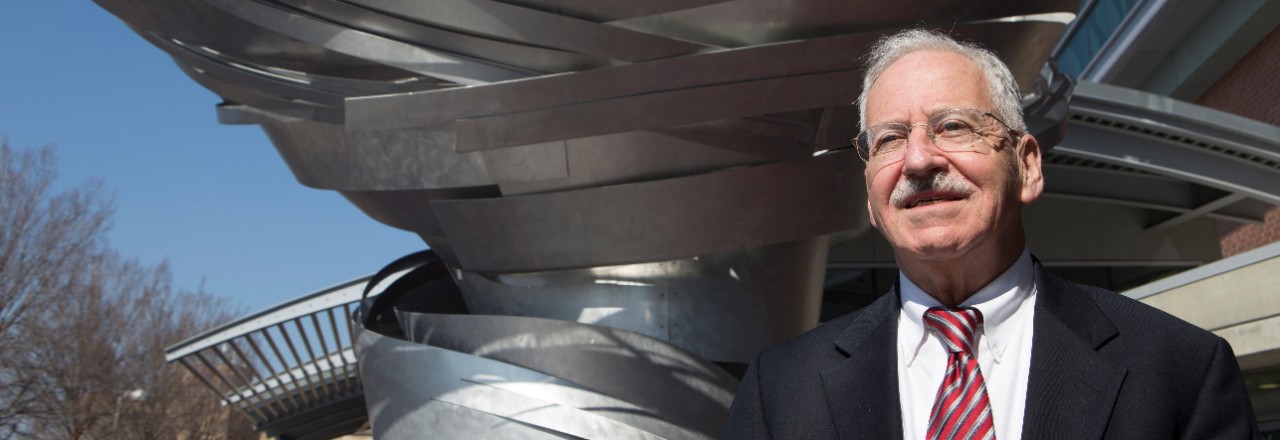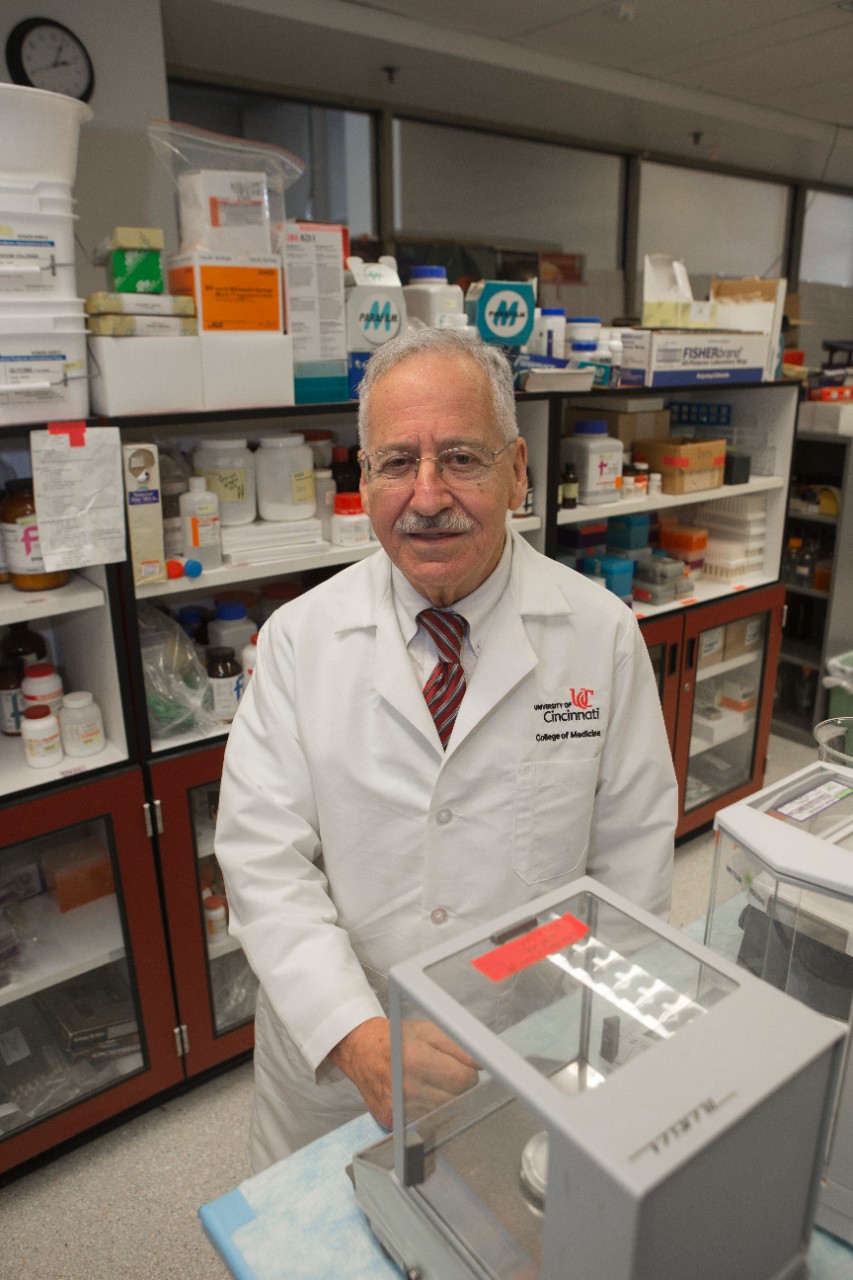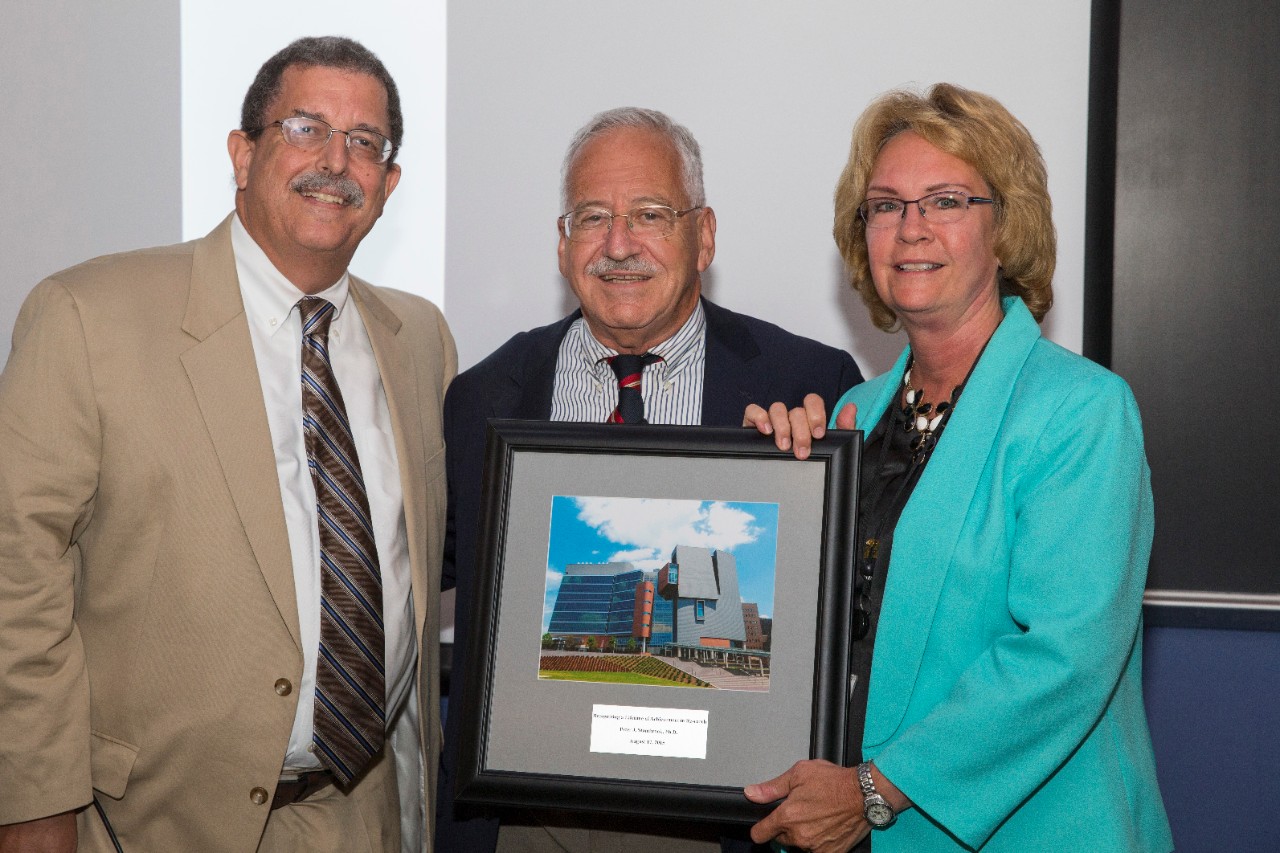
Dr. Peter Stambrook remembered as illustrious researcher, mentor and friend
Former chair of Cancer and Cell Biology and Drake Medalist died Oct. 1
Peter Stambrook, PhD, former chair of the Department of Cancer and Cell Biology and 2013 Daniel Drake Medalist, died Oct. 1. He was 79.
Stambrook was an internationally respected cancer researcher. Described as a brilliant scientist, visionary, fine gentleman and trusted mentor, he was a dedicated educator who strongly supported students and was a generous benefactor of the University of Cincinnati College of Medicine supporting future generations of scientists.
Anil Menon, PhD, professor in the Department of Molecular Genetics, Biochemistry and Microbiology and associate dean of baccalaureate education, fondly recalled meeting Stambrook for the first time when he was just starting in the UC graduate program and Stambrook was a young faculty member. Menon was looking at a scientific poster when Stambrook stopped and started asking him questions. “I was doing my best to answer, and he was just delightful. He helped me understand his research. My first memory of him was of this generous person who shared his knowledge with enormous care and goodness,” Menon said.
That chance encounter began a close, long-term friendship. After receiving his doctorate, Menon did postdoc work at Harvard School of Medicine. Stambrook would stay with Menon and his young family in their small apartment whenever he attended conferences in Boston. “He became part of our family,” Menon said.
When asked about their first thoughts of Stambrook, colleagues usually talked about his passion for helping students, trainees and young faculty.
“A hallmark of Peter was his strong commitment to developing the careers of young faculty,” said Kenneth Blumenthal, PhD, a former UC faculty member and professor and chair of the Department of Biochemistry at the State University of New York at Buffalo Jacobs School of Medicine and Biomedical Sciences, who has known Stambrook for more than 40 years. “His influence transcended departmental boundaries. I know of at least four junior colleagues in molecular genetics who have told me unsolicited stories of how Peter helped move their early careers forward, whether by offering advice, starter funds or by helping them to network in the national research community.”
“Peter had a love and a talent for connecting people. He was the consummate networker long before networking became a thing,” said Carolyn Price, PhD, professor in the Department of Cancer Biology. “He would host functions at his home that would bring together UC scientists, physicians and members of the Cincinnati community. He would identify research areas that needed to be developed within UC and would spearhead efforts to build programs to fill the void.”

Peter Stambrook, PhD
Bringing people together, especially from different areas, was a hallmark of Stambrook.
“Perhaps his greatest attribute, personality aside, was his interdisciplinarity. He recognized early on, perhaps sooner than some of his colleagues, that traditional disciplinary lines which had characterized research in the biomedical sciences, were becoming increasingly blurred. This encouraged him to reach out to colleagues in other departments who shared common areas of interest but had slightly different primary expertise. One outcome of this outreach was to engender multi-investigator training and research grant applications much stronger and more broadly based, and more successful, than had been common at UC previously,” Blumenthal said.
Price added that Stambrook spent countless hours assisting junior faculty members with their grant proposals, never giving up until their RO1 was finally funded. He also spent countless hours personally mentoring students.
When he received the Daniel Drake Medal, Stambrook said that one part of his job that he enjoyed as much as any other was “the opportunity to interact with so many students, postdoctoral fellows and young faculty and watch them mature into successful professionals. There is no more gratifying feeling than to know that one might have played a part, no matter how small, in helping this maturation process.”
For the last 32 years, Stambrook directed a National Institutes of Environmental Health Sciences Environmental Carcinogenesis and Mutagenesis training grant that supported more than 100 trainees. Earlier this year, he was instrumental in getting the grant refunded. Alvaro Puga, PhD, professor in the Department of Environmental and Public Health Sciences, is a co-principal investigator with Stambrook and William Miller, PhD, professor in the Department of Molecular Genetics, Biochemistry and Microbiology, on the training grant.
“You should know how much effort he dedicated to getting that grant funded this last year, at a time that his strength was already dwindling,” Puga said. “He fought with NIH when they made a mistake and were going to withdraw his grant after review, to the point that not only the grant was reinstated but also got an apology from NIH. He battled fiercely for the training and development of the students, challenging them to think and establishing a scientific and personal rapport with them that would last for many years.”
Stambrook also was known for the wise advice he offered his colleagues. Jun-Lin Guan, PhD, Francis Brunning Endowed Chair in the Department of Cancer Biology and current chair of the department, said that “as fellow cancer biologists, I feel that Peter has given me the most in all his wisdoms on research, recruitments and working with leadership colleagues.” Syed Ahmad, MD, Hayden Family Endowed Chair for Cancer Research and co-director of the UC Cancer Center, added that Stambrook was “a trusted mentor” from whom he would seek advice on many topics, “some related to science and much unrelated to science.”
Ken Greis, PhD, said that he always valued Stambrook’s advice and that he will miss the opportunity to chat with him about research, training, core facilities, and a wide variety of other topics.
“In addition to research and training, Peter was a tireless advocate for research infrastructure including shared equipment and core facilities,” Greis, associate dean for research core facilities, said. “When I first came to UC to set up proteomics and mass spectrometry capabilities in 2006, Peter was one of my first customers and a primary advocate. As I progressed into broader roles with planning and oversight for core capabilities, I routinely sought insight from Peter who was always eager to provide his perspective and advice. He will be greatly missed.”
Friend and colleague of 45 years Jay Tischfield, PhD, said that Stambrook was extraordinarily generous with his time and intellect and was responsible for much of the success in his career. Together they co-authored 61 publications.
“We spent many hours walking the streets of cities where we jointly attended meetings, discussing our science, the next grant application, or the future. These walks resulted in many joint research grants from NIH and NSF and a couple of patents. Peter was always the optimist, eager to inform me of why a grant application would be successful,” said Tischfield, the Duncan and Nancy MacMillan Distinguished Professor of Genetics at the Robert Wood Johnson Medical School in Piscataway, New Jersey. “On the other hand, I was the pessimist usually describing the ways in which our application and experiments would fail spectacularly. Most often, Peter was right.”
His colleagues noted that even with his recent health issues, Stambrook was still working diligently.
“Even during his last few weeks, he would come into my office with new papers he was reading and advising me on what research programs we needed to invest in to keep UC ahead of other institutions,” Ahmad said. “He knew his time was limited, and despite this, continued to mentor and continued to advance the UC Cancer Center priorities. His primary goal, always, was to make an impact on cancer. But in doing this, he mentored and befriended countless people. His impact will last for decades. He accomplished his goals; he did make an impact on cancer research.”
Stambrook’s research prowess was extraordinary. He attracted millions of dollars in research funding and made seminal discoveries in his field. He became interested in DNA replication and cell cycle regulation as a graduate student at the State University of New York at Buffalo, where he received his doctorate in developmental biology. Stambrook was the first to show that, in a vertebrate organism, the temporal sequence with which DNA duplicates itself can change during embryogenesis. His laboratory also studied the health risks associated with environmental chemicals that function as potential mutagens and carcinogens and represent a significant health risk to the population significantly increasing the risk of cancer, birth defects and other genetic disease. More recently, his work was focused on understanding genomic instability, particularly as it relates to cancer, and on a critical signaling pathway that responds to DNA damage.
“Peter was always ahead of the curve with regards to where cancer research was heading,” Ahmad said. “As an example, he recommended UC get involved in microbiome research several years before it became a mainstream research program at most institutions. Peter was well-known internationally, and he would leverage his reputation and connections to benefit cancer research at UC.”
Stambrook served as scientific director and chairman of the Israel Cancer Research Fund and as co-leader of the UC Cancer Center’s Comprehensive Head and Neck Cancer Program. Chad Zender, MD, professor in the Department of Otolaryngology-Head and Neck Surgery, and Trisha Wise-Draper, MD, PhD, associate professor in the Department of Internal Medicine, said Stambrook partnered with Jack Gluckman, MD, former chair of the Department of Otolaryngology, to develop one of the first translational research programs in head and neck cancer. The program has evolved into one of the most successful cancer programs in the UC Cancer Center.
Sohaib Khan, PhD, emeritus professor in the Departmental of Cancer Biology, said Stambrook “had the unique ability to grasp the research programs of not only faculty of his department, but university-wide cancer biology investigators. His depth of knowledge was remarkable and evident during research seminars and focused research meetings. Peter had a truly illustrious career.”
Stambrook’s research did not diminish after he took on significant administrative responsibilities. Beginning in 1994 he served for two years as acting chair of the Department of Cell Biology, Neurobiology and Anatomy. He was made chair of the department and Francis Brunning Endowed Chair in 1996, serving until 2008. He was named a distinguished research professor in 2015 and emeritus professor in the Department of Molecular Genetics, Biochemistry and Microbiology in July.
Khan recalled the important role Stambrook played in recruiting Elwood Jensen, PhD, to UC in 2002. Jensen, who discovered the estrogen receptor, had been a distinguished professor at the Karolinska Institute in Stockholm. While there to present a seminar, Khan asked Jensen if he would be interested in coming to UC, and he was. Stambrook, who was chair of Cell Biology at the time, realized the coup it would be for Jensen to join the UC faculty and worked with Dean John Hutton, MD, to attract Jensen to Cincinnati. Jensen, who died in 2012, remained at UC for the rest of his life and was the recipient of a Lasker Award in 2004.
Stambrook was passionate about the future of the College of Medicine and the university as a whole, noted Litsa Kranias, PhD, Hanna Chair of Cardiology. She said “his amazing level of positive energy and his vision for the college” always stood out. But she also recalls his munificent side.
“We talked on the phone just six days ago (before his death) and he wanted me to take care of some things because he might not be able to. One of them was to help some colleagues in an under-privileged country to publish their work,” Kranias said. “In the past few months, as we discussed COVID and the restrictions on travel, he told me that he had kept in touch with one of the cab drivers/tour guides in Mongolia, who was not able to fly back home as the airfare had gone up tremendously and Peter paid for that! What a personable, compassionate and kind human being who will always guide us as a role model.”
Stambrook was born in London in 1941. His Jewish parents had fled Vienna in 1939 and after arriving in England anglicized their last name from Sternberg to Stambrook. His father, who had worked in a fabric company in Vienna, joined the British army and rose to the rank of captain while Stambrook and his mother, a classical pianist, lived in London. Menon believes that growing up in London during the war helped mold Stambrook into an advocate for those less fortunate.
“Throughout his life he would support people who were refugees from life in various circumstances in the world. He had mentees in Mongolia, in Serbia, all across the world who he helped in a very quiet way. He would never advertise this, but he would send them money, encouragement, good wishes. These were things that helped people on the precipice. And Peter was always there for them,” Menon said.
As a person, Kranias described Stambrook as “a fine gentleman, very considerate of others and their needs and a kind human being.” Menon recalled Stambrook’s warm smile and delightful sense of humor, although he was known for sharing terrible puns. “I groaned at them. But he always tried to bring good cheer,” he said.
Stambrook was an avid soccer fan and had been a good player. He also was a black belt in judo. “Although he was small and wiry, he could throw anyone. He was not physically intimidated by people twice his size,” Menon said. Blumenthal also recalled Stambrook’s competitiveness on the tennis court.

Dr. Peter Stambrook, center, receives a Lifetime Achievement in Research Award in 2015 from former College of Medicine Dean William Ball, MD, and Melanie T. Cushion, PhD, senior associate dean for research
Stambrook’s family immigrated to the United States in 1953 settling in Ithaca, New York. He attended the prestigious Millbrook School in Dutchess County, New York, then received a bachelor’s degree in biology from Rensselaer Polytechnic Institute in Troy, New York, and a master’s degree in zoology from Syracuse University. After receiving his doctorate, Stambrook completed a two-year postdoctoral fellowship in the Department of Cell Biology at the University of Kentucky Medical Center. In 1971, he became an assistant investigator in the Department of Embryology at Carnegie Institution of Washington. His initial faculty appointment came three years later at Case Western Reserve University, where his lab was the first in Cleveland to use recombinant DNA technology.
In the fall of 1980, Stambrook attended an American Society for Cell Biology annual meeting in Cincinnati. He met Edna Kaneshiro, PhD, a professor in the UC biology department, at the meeting. Kaneshiro told him about Robert Cardell Jr., PhD, the new UC anatomy department chair, who was looking to recruit a molecular biologist to join his department. Kaneshiro introduced the two and just days before New Year’s Day 1981, Stambrook and his wife were on their way to Cincinnati where he would be an associate professor. Four months after arriving in Cincinnati, Stambrook left for a year as a Senior Fogarty Fellow to work at St. Mary’s Hospital Medical School in London.
When he died, Stambrook was past president of the Society for Experimental Biology. He also served as president of the Environmental Mutagen Society and as a trustee for 15 years of the Ohio Division of the American Cancer Society. He was involved in numerous other scientific organizations, both as a member and in various leadership roles, and was an invited speaker throughout the world.
Stambrook was the recipient of numerous prestigious honors. He was elected a Fellow of the American Association for the Advancement of Science in 2007 in recognition for his contributions to the understanding of in vivo mutagenesis and recombination between homologous chromosomes, as well exceptional service as president of the Environmental Mutagen Society and as the editor of the journal Mutation Research: Fundamental and Molecular Mechanisms. In 2013 alone he received the EMGS (Environmental Mutagenesis and Genomics Society) Award for his seminal contributions to the field; UC’s George Rieveschl Jr. Award for Distinguished Scientific Research; and the Daniel Drake Medal. He received the Distinguished Scientist Award in 2015 from the Society for Experimental Biology and Medicine and was celebrated that year at the College of Medicine with a Lifetime Achievement in Research Award. Last month, Stambrook was honored by the Israel Cancer Research Fund with the establishment of the Peter Stambrook Award in Cancer Medicine.
Stambrook is survived by his wife, Mary Piper, an emerita librarian at the Harrison Health Sciences Library; daughter, Elizabeth Stambrook, a senior clinical research professional in the Department of Internal Medicine, Division of Infectious Diseases, and her husband; and a granddaughter, Piper.
Photos by Colleen Kelley/UC Creative + Brand
Related Stories
UC professor Ephraim Gutmark elected to National Academy of...
December 20, 2024
Ephraim Gutmark, distinguished professor of aerospace engineering at the University of Cincinnati, was elected to the 2024 class of the prestigious National Academy of Inventors.
UC study examines delivery timing in mothers with chronic...
December 19, 2024
In a study recently published in the journal O&G Open, University of Cincinnati College of Medicine physician researchers found 39 weeks of gestation is optimal for delivery in mothers with chronic hypertension.
Winter can bring increased risk of stroke
December 18, 2024
The University of Cincinnati's Lauren Menzies joined Fox 19's morning show to discuss risk factors for stroke in the winter and stroke signs to look for.
